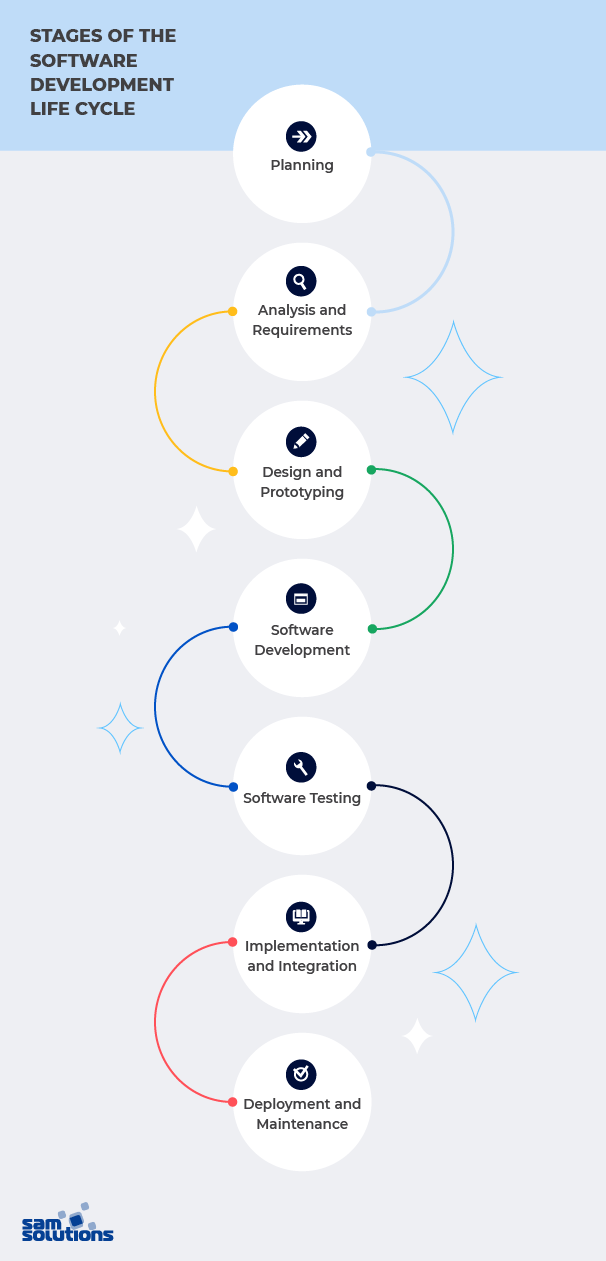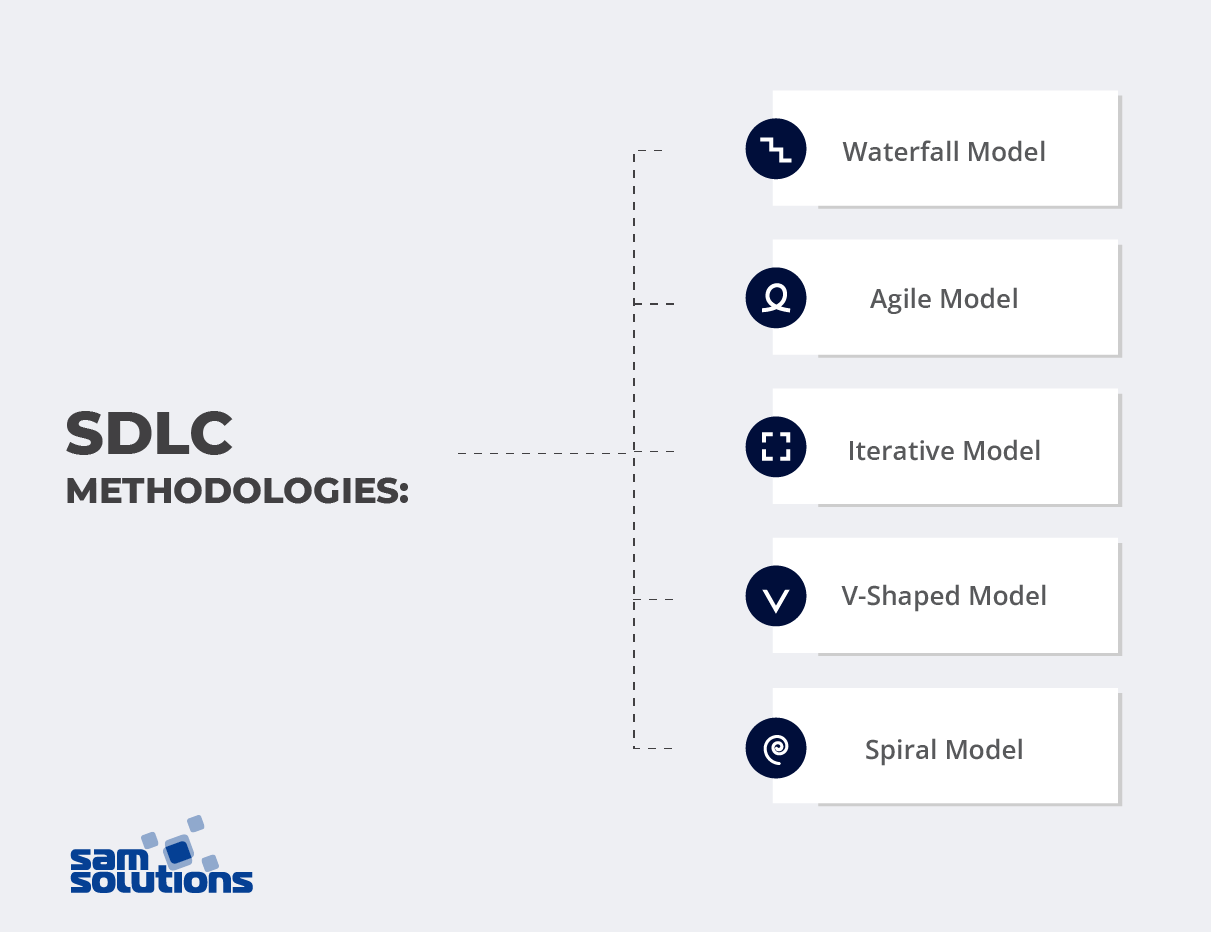IT companies deal with complex, heavy-load projects. To manage and control all the necessary steps to create the final product, and navigate through all the project activities smoothly, teams make use of the Software Development Life Cycle (SDLC). In this article, we will explore this concept and discuss the important stages of the product life cycle, most popular SDLC methodologies, and their benefits.
What Is SDLC
Software Development Life Cycle (SDLC) refers to the process utilized by IT companies to optimize the development of high-quality product. Its ultimate goal is the efficient production and delivery of top-performing software within time and money constraints, according to the client’s needs and preferences regarding the product.
There are different possible approaches to SDLC, in this article, we will consider a typical one. At SaM Solutions, we have a formalized SDLC approach, which we adapt to the unique customer needs of a specific product.
Develop your custom software with SaM Solutions’ engineers, skilled in the latest tech and well-versed in multiple industries.
How Does SDLC Work
SDLC involves several major steps that happen in sequence. The life cycle is basically an essential plan for high-quality software development. If team members are able to keep to this plan of the life cycle, it will help lower the project’s cost and delivery period, and upscale the product quality.
Different popular SDLC models can be used on the projects to fulfill the customer’s wishes, and ultimately, there is no single one-size-fits-all approach that is suitable for the life cycle of all projects. To choose the development life cycle model that will work best for your product, you should evaluate your resources and customer needs, as well as the specifics of the project’s domain and the product under development.
Stages of the Software Development Life Cycle

Planning Stage
As the first initial stage of the development process, the planning stage determines the primary objectives of the final product. It is an essential, integral stage of the product life cycle that forms the basis for all the subsequent actions. Being an important compound process, it includes these three phases:
- Identifying the system to be developed
- Assessing how viable the project is
- Making a final upper-level plan
These steps help determine the challenges of the projects and the volume of work that has to be done during the upcoming product life cycle stages. This preparatory stage of the SDLC forms the preliminary foundation of the expected work. It outlines the future procedures of the life cycle, allocates resources, schedules the timeframe and deadlines and helps prevent issues that might otherwise arise.
Analysis and Requirements Stage
When clients decide to use the services of a software company, they often have a hazy notion of what to expect. That is why a thorough requirement analysis is necessary at this stage of life cycle. To perform these activities, strong collaborative relationships between various teams are mandatory during the whole development life cycle. Business development specialists, marketers, programmers, and other professionals from specific spheres work together with this aim.
The team collects all the necessary information and determines the preliminary ideas for creating a prototype. Programmers specify the conditions for prototyping, estimate the possible alternative options, as well as design the documents, according to which all the work will be carried out.
Design and Prototyping Stage
The following SDLC phase includes the development of general architectures of the systems. Software engineers define how each module functions and interacts with third-party modules. Software design precedes the actual coding of the software. Programmers summarize all the information, alongside particular characteristics. This can include factors such as the UI, interfaces of the systems, networks, databases, and preconditions.
This SDLC stage is involved in the thorough description of all the desired functions, characteristics, and qualities of the software. Designing turns the specifications documents into a more well-organized shape. Afterwards, the team creates a prototype — a model — and tests and refines it until the preferable level of quality is achieved.
Software Development Stage
Once the design document is prepared, programmers put all the guidelines they receive into practice. They write the source code and build the software in the required programming language.
If all the previous SDLC phases were performed properly, the coding stage should be clear and uncomplicated. While coding, programmers utilize software development best practices and instructions that are set up by the IT companies and clients. Various development tools and techniques are used as well, such as project management and bug tracking tools, various search tools, preprocessors, cache systems and databases.
Leverage SaM Solutions’ decades-long expertise in IT to develop high-quality custom software for your business.
Software Testing Stage
Quality assurance is of crucial importance in software development projects. Running tests helps companies to carry out a thorough evaluation of the way the software functions and its important features. Thanks to this evaluation, it is possible to make estimations, if the product meets all the customer desires and pre-set goals.
Both manual and automated tests are aimed at the identification of any possible bugs and malfunctions of the product prior to its implementation. There are a lot of possible product testing options, and the choice of the specific test depends on the exact goal of the product.
Without this important SDLC stage, clients can experience technical issues that can lead to potential financial losses. Identification of problems at an early product testing phase can prevent all these problems.
Implementation and Integration Stage
The main aim of this stage of the product SDLC is the installation of the created software into the production environment and setup of all the required configurations. The team ensures that the software meets all the pre-set technical criteria and suits the business demands.
Another issue that software engineers should devote their attention to is to check if the final product follows all the software documentation and technical guidelines.
At this product SDLC stage, the team runs the app in order to make sure that it operates correctly. Then programmers ensure that it follows all the integration criteria regarding such factors as user interaction, data transformation, communication, safety regulations, administration, and support.
Deployment and Maintenance Stage
The final SDLC stage is the deployment of the program, after which the customer can actually utilize it and enjoy the functions it offers. Often companies choose to deploy the program firstly in test and pre-production environments, and only afterwards in the real one. This multiple-stage method helps improve the safety of the app.
When the app is released, it doesn’t mean that no issues will arise in the future. Down the road, customers may require additional features in accordance with new demands. This can potentially lead to the necessity of code alterations. Likewise, technical issues may arise that will need to be solved quickly, in order to ensure the proper functioning of the information system.
Basic SDLC Methodologies

Waterfall Model
Companies have used the waterfall model for decades, and this SDLC approach is still popular in IT projects from various business domains. It is strongly focused on specific pre-set sequential steps, and each step can begin only after the previous one finishes.
Waterfall model is considered to be easy and comprehensible, with clear-cut expectations from each phase. Within these limits, it is easy to make prioritization and choose the most fundamental goals. However, it is not an option if your project is complex and time-intensive.
Developers integrate the software at the end of the cycle. The program is completed after all stages are finished.
This approach is most often used for short-term projects, when there is a strict well-defined scope of requirements and development methods towards the created product. It is especially favorable for products with high level of social and material responsibility, such as in healthcare or finance domains.
Agile Model
The Agile approach centers on the quick cyclical delivery of the product. This SDLC approach welcomes frequent changes, tests, experiments and adjustments. It incorporates multiple releases that can occur often, in some cases even several times a day. This method implies active customer involvement, which makes the approach towards the development extremely flexible. It doesn’t require any detailed plans, it is sufficient to have a preparatory arrangement only.
During the work process, customers frequently decide to add new features that were not planned at the start. These adjustments are affordable to implement while there are several iterations. However, due to constant amendments, it may be difficult to measure the ultimate price and time limits of the projects. The agile method works best for changeable products and platforms with a wide spectrum of users. This model has proved to be one of the most widespread and effective ones, with minimal risks and quick releases.
Iterative Model
The iterative model focuses on the repeated delivery and division of complex development processes into fractional segments. It is possible to identify any malfunctions at the initial stage and add adjustments gradually. One of the positive sides of this SDLC method is that it allows changes to be introduced quickly, and it is often a budget-friendly approach.
The iterative approach can be more pricey than the classic Waterfall one and needs especially close supervision due to its volatile nature. It is best suited for the development of systems with clear pre-set goals, especially in large projects.
V-Shaped Model
This method is an extension of Waterfall technique. It has several consecutive processes and is built on comprehensive QA, so a highly qualified testing team plays an especially significant role in this SDLC approach. It is very rigid and inflexible, and each stage should be validated and verified to have definite results for the utmost quality.
Furthermore, it is popular thanks to its simplicity and user-friendly structure. This SDLC model is mainly used in projects when the requirements are clearly defined and are not likely to change. V-shaped model works best when the project is small-sized or medium and has clear requirements.
Spiral Model
Implemented as a number of repeated cycles, the Spiral model is preferred for large-scale, expensive, and complex projects. In this SDLC model, strong emphasis is put on analyzing risks and evaluating statistics, as well as relying on comprehensive documentation. The team repeats all stages of projects continually in a spiraling movement.
This approach is an advanced one, used for the development of custom software for hard projects when the user expectations for the final product may be unclear. It may result in extra costs and require a huge number of transitional steps. The spiral model is not suitable for small- and medium-sized businesses and is often preferred by big businesses.
Benefits of SDLC
It’s not easy to complete heavy-load projects without a definite strategy in mind. Therefore, SDLC as a plan can streamline the collaborative work of different teams on a project. There are a lot of disputes regarding which kind of methodology to choose, as each one has its own benefits and drawbacks. To choose a definite methodology, the team should take into account their resources, the specifics of the project, and the client’s desires.
Regardless of which methodology you choose, using SDLC will give your team the following advantages:
- Basis for making a structured plan and schedule
- Specified communication tools
- Unified language
- Transparent set of responsibilities among architects, coders, testers, systems engineering specialists, and other team members
- Clearly set results at each stage of the project
- Comprehensive estimation of the required resources
- Improved security
- Increased speed of product delivery
- Better connection with the client
These advantages can help create a high-quality product within the determined resources and time constraints, in accordance with all relevant documents and best practices. Nevertheless, you should bear in mind that it’s possible to enjoy all these SDLC advantages only if all the team members genuinely stick to the plan.
Conclusion
SDLC can introduce huge benefits into any software development project. This article has shown you a more comprehensive view of SDLC’s structural elements, most widespread approaches, and major benefits that it can offer to your enterprise. When choosing a particular SDLC approach, we recommend you focus on the unique characteristics of your project and the specifics of business demand.



















 The Latest 15 Information Technology Trends in 2024
The Latest 15 Information Technology Trends in 2024 Top 10 Embedded Software Development Tools
Top 10 Embedded Software Development Tools IaaS vs. PaaS vs. SaaS: What’s the Difference?
IaaS vs. PaaS vs. SaaS: What’s the Difference? IoT Development: Top 15 Internet of Things Tools and Platforms in 2024
IoT Development: Top 15 Internet of Things Tools and Platforms in 2024 10 Examples of Predictive Analytics
10 Examples of Predictive Analytics











![[Tech Talk] What Developers Should Know About SQL Optimization, Part 1: Fundamentals](https://www.sam-solutions.com/blog/wp-content/uploads/fly-images/30279/SQL-video-cover-370x238.webp)
 MACH Technology: What Is It?
MACH Technology: What Is It? The 16 Best .NET Development Tools
The 16 Best .NET Development Tools How to Create Your Own CRM System: A Step-by-Step Guide
How to Create Your Own CRM System: A Step-by-Step Guide How to Create Artificial Intelligence Software
How to Create Artificial Intelligence Software The Ultimate Guide to Conducting an Audit of Your Ecommerce Website
The Ultimate Guide to Conducting an Audit of Your Ecommerce Website
I agree that there cannot be a unified approach while choosing Software Development Life Cycle (SDLC). For some projects the V-Shape model is perfect, for others Agile is the best.
Thanks, now I know what the most widespread SDLC methodologies are. I knew about Agile and Waterfall, but had no idea that there was something like Spiral or Magic Box.
@kilian do you mind to enlighten me with your knowledge about Magic Box? I will be grateful with your response.
The agile software development life cycle model is the most convenient approach in comparison with other methods. As far as I am able to judge, it gives the greatest amount of flexibility on the project, which I appreciate.
As a customer, I’ve worked with the Prototype model and was absolutely satisfied. I found it particularly beneficial to witness the changes I wanted implemented so quickly. However, it was pricey, but anyway I would definitely recommend it to my colleagues.
Thank you for the detailed analysis of all the software development life cycle steps. Now I have a better idea of how one stage follows the other, and how all these steps are connected.
I think the Agile software development life cycle method is the best technique possible. My team and I worked with other models, such as Waterfall, but it wasn’t nearly as successful as Agile!
I can’t imagine how programming was possible at all before all these software development life cycle models? It’s impossible to complete any project successfully without using one of these.